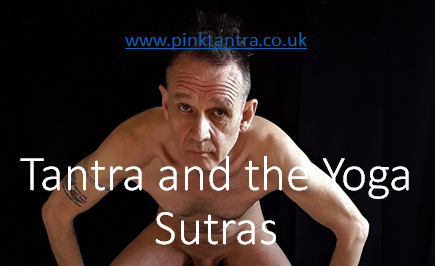Tantra and the Yoga Sutras
I have completed reading Edwin F Bryant’s tome of a book The Yoga Sutras of Patanjali, Swami Vivekananda’s Patanjali’s Yoga Sutras, and Alan Finger’s Tantra of the Yoga Sutras. Below are what I have taken from this combined reading.
 Everything starts with a state of singularity, universal intelligence (Brahman). Then there was the Big Bang (Union of Shakti/Shiva), which ejaculated out as the manifested universe (some call this Ishvara), creating duality and diversity, the time-space continuum (Maya). Out of this comes the creation of individual beings (Little Bang).
Everything starts with a state of singularity, universal intelligence (Brahman). Then there was the Big Bang (Union of Shakti/Shiva), which ejaculated out as the manifested universe (some call this Ishvara), creating duality and diversity, the time-space continuum (Maya). Out of this comes the creation of individual beings (Little Bang).
All beings are woven together through rajas – expansion - tamas - contraction - and sattva – balance point (The 3 Gunas). This leads to consciousness that is our individual expression of universal intelligence (Atman – Spirit). However, there are two aspects to Atman (1) Spirit, which is consciousness that relates back to Brahman (Param-atman) and (2) spirit, which is consciousness that related to living in the world of the senses (Jiva-atman).
Param-atman leads to consciousness as the witness (Purusha), which is expressed through (Chitta), the energy field in which all of mind’s movements arise. Jiva-atman leads to (Prakriti), the world of the senses, which in turn processes (Maya) through mental activity (the Mind), primarily through pain and pleasure (the 5 Vittri), which are undistorted knowledge, misconception, imagination, sleep and memory.
When we attain consciousness as the witness (Purusha) expressed through (Chitta) we see things as they are (Viveka) and respond from the nondual mind. When we work out of the senses (Prakriti) we rely primarily on information from the senses, memory, and the I-maker (Ego), resulting in twisted perceptions (Avidya), leading to reactions from the ego rather than responses from the nondual mind.
This has significant consequences in terms of the intention behind our practices. Are they driven by our desires and attachments for self-gratification, are they ego driven, are they shifting from self-pleasure to self-love, and from self-love to total-love, are they in alignment with ‘Atman – Spirit’? How would we know? This is where it is important to engage in spiritual enquiry as well as tantric practices, to get at the truth of our mental patterns, to help us shift from Prakriti to Purusha.
The way we shift from Prakriti to Purusha, from reacting to responding, from Avidya to Viveka, it is suggested, is through the (8 Limbs of Yoga). These 8 Limbs of Yoga are a non-linear process of purification, a process of deprogramming to reprogramming, working through Yama, Niyama, Asana, Pranayama, Pratyahara, Dharana, Dhyana and Samadhi. That is, tantric practice, spiritual enquiry, and an integration and surrender to the resonances in everyday life where we recognise the experiences of truth through an ongoing meditative state of equanimity.
The 8 Limbs of Yoga offer a good point of departure for this. The (Yamas) are the principles of self-regulation to de-programme our mental patterns. They consist of (Ahimsa) where we neutralise our impulses towards aggression, (Satya) where we bring clarity to eliminating untruths and lies we tell to others and ourselves, (Asteya) where we let go of wanting what others have and trusting that the universe will give us what we need, (Brahmacharya) where we align our creative force with the greater intention of Brahman, our individual expression of universal intelligence, and (Aparigraha) where our desires and attachments no longer own us.
The (Niyamas) are the principles of self-training to help us reprogramme our mind to attune to universal intelligence. They consist of (Saucha) the cleansing of the mind and body, so we have a pure and easeful relationship with our lived and surroundings, (Santosha) where we accept what is, accepting challenges as our Karma and live in alignment with our Dharma. Our Karma is the experiences in our lives and how we respond to them, and Dharma is the structures of our life (family, culture, natural skill set, etc). (Tapas) is where we bring discipline and surrender to a focussed mind for practice and spiritual evolution, (Svadyaya) is self-awareness and deep investigation, and (Ishvara pranidhana) is devotion and surrender to the divine, universal intelligence.
Asana is the practice of developing a stable and relaxed body (especially our seated posture), quieting our natural restlessness, and an absorption in the Now. Pranayama is the practice of inhalation and exhalation and retention or pausing the breath to move or develop energy and bring inner light and concentration. Pratyahara is when the mind is drawn inwards, away from the senses, towards pure consciousness. Dharana is one-pointed focus of our awareness through effort. Dhyana is effortless concentration. Samadhi comes when the mind is truly absorbed, experiencing pure consciousness.
Bringing it all together
From a Tantric perspective we expand our consciousness for the purpose of weaving the insights and wisdom gained back into our lived life, so we can re-engage with the world in a new way. In a way that takes us beyond our limited patterns, beyond the ego, aligning us with the flow of universal intelligence. This, from a Tantric perspective, is freedom; the freedom to transcend and re-engage, a cyclical process of spiritual evolution.
Connect on Twitter / Facebook / JustFor.Fans
Email me direct if you are interested in mindful, trauma-informed, intimacy or spiritual coaching, or if you would like to join my new Pink Tantra Towards Awakening group for chat rooms, video channels and in-person workshops around tantra and intimacy practices robert.pinktantra@gmail.com
See my personal development / personality profiling book DISCover the Power of You published through John Hunt Publishing Ltd, 2017. ISBN: 978-1-78535-591-2
And for a bit of light reading, see my first historical fictional novel Fermented Spirits published through Austin Macauley Publishers, 2022. ISBN-13: 978-1398437159